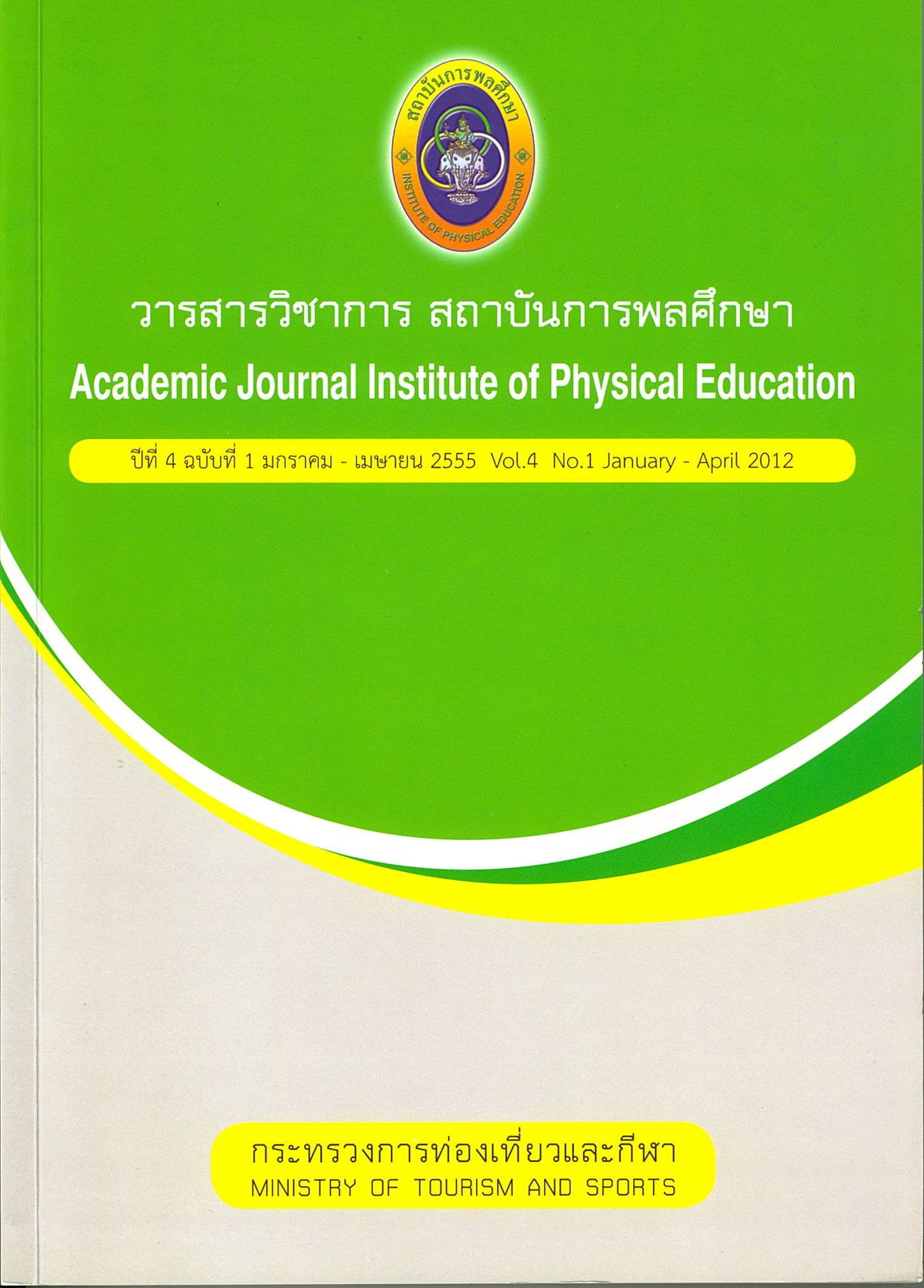THE EFFECT OF THE MATRIX OF NINE SQUARES TRAINING AND FLEXIBILITY ON AGILITY
Main Article Content
Abstract
The purpose of this study was to investigate and to compare the effect of the matrix of nine squares training and flexibility training on agility after 4th and 8th weeks of training. Forty subjects were randomly sampling from Private first class soldiers from King Mongkut Hospital, Bangkok, ranging of age between 21-22 years old. Subjects were divided into 4 groups, 10 in each group. The control group did not receive training
whereas the experimental group 1 practiced the matrix of nine squares, the experimental group 2 practiced flexibility and the experimental group 3 practiced the matrix of nine squares and flexibility, three days a week on Monday, Wednesday and Friday from 5.00 to 7.00 am. Agility was measured in all groups before and after the 4th and 8th weeks of training. Data were analyzed using analysis of variance with repeated measures and multiple comparisons were conducted through Tukey's method. All statistical significance was set at .05 level.
Results indicated that the agility mean scores of the experimental groups 1, 2 and 3 after the 4th and 8th weeks of training were significantly better than the control group. However, agility mean scores of the experimental group 1, 2 and 3 did not significantly differ. Further, the agility mean scores of all the experimental groups after the 4th and 8th weeks of training were better than prior to training. In summary, all training methods were appropriated for developing agility. In additions, the matrix of nine squares training combined with flexibility was the best method to develop agility, whereas solely training with the matrix of nine squares and flexibility training which ranked 2nd and 3rd respectively improved the agility.
Article Details
The published article is a copyright of the Academic Journal of Thailand National Sports University. The passage appeared in each article in this academic journal is a perspective of each author which is not related to the journal. Each author is required to be responsible for all components of his/her own article. If there are any mistakes, each author must be responsible for those mistakes on his/her own.
References
เกชา พูลสวัสดิ์. (2548). ผลของการฝึกเสริมพลัยโอเมตริกที่มีต่อการพัฒนาความคล่องแคล่วว่องไวของนักกีฬาฟุตบอลอายุระหว่าง 14-16 ปี. วิทยานิพนธ์ปริญญาโท, จุฬาลงกรณ์มหาวิทยาลัย.
เกรียงไกร อินทรชัย. (2547). ผลของการฝึกความอ่อนตัวและความแข็งแรงของกล้ามเนื้อที่มีต่อระยะทางในการทุ่มลูกฟุตบอล, วิทยานิพนธ์ปริญญาโท, มหาวิทยาลัยเกษตรศาสตร์.
เจริญ กระบวนรัตน์. (2547). วิทยาศาสตร์การกีฬาสําหรับกีฬาเทนนิส.กรุงเทพ ฯ : กองวิทยาศาสตร์การกีฬา ฝ่ายวิทยาศาสตร์การกีฬา.
การกีฬาแห่งประเทศไทย. (2548). นวัตกรรมทางการศึกษากับตาราง 9 ช่อง, ภาควิชาวิทยาศาสตร์การกีฬา คณะศึกษาศาสตร์, มหาวิทยาลัยเกษตรศาสตร์.
การกีฬาแห่งประเทศไทย. (2552). การยืดเหยียดกล้ามเนื้อ, กรุงเทพฯ: คณะศึกษาศาสตร์, มหาวิทยาลัยเกษตรศาสตร์.
พีระพงษ์ บุญศิริ. (2536), สรีรวิทยาของการออกกําลังกาย, กรุงเทพฯ: สํานักพิมพ์โอเดียนสโตร์.
มาลีรัตน์ มณีเขียว. (2544). ผลของการฝึกวิ่งรูปแบบตัว S และรูปแบบตัว Z ที่มีต่อความ คล่องแคล่วว่องไวของนักกีฬารักบี้ฟุตบอล, วิทยานิพนธ์ปริญญาโท, มหาวิทยาลัยเกษตรศาสตร์.
วราภรณ์ ไชยสุริยานันท์. (2546). การสร้างเครื่องมือวัดความอ่อนตัว, วิทยานิพนธ์ปริญญาโท, มหาวิทยาลัยเกษตรศาสตร์.
สนธยา สีละมาด. (2551). หลักการฝึกกีฬาสําหรับผู้ฝึกสอนกีฬา, กรุงเทพ ฯ : สํานักพิมพ์แห่งจุฬาลงกรณ์มหาวิทยาลัย.
หาญพล บุญยะเวชชีวิน. (2535). “Sport Conditioning” วารสารสุขศึกษา พลศึกษาและสันทนาการ, 18(4):22-23.
อรนุช ศรีเขียวพงษ์. (2546). ผลของการฝึกความแข็งแรงและความอ่อนตัวที่มีต่อความคล่องแคล่วว่องไวของนักฟุตบอล. วิทยานิพนธ์ปริญญาโท, มหาวิทยาลัยเกษตรศาสตร์.
อัจฉรา ช่วยจันทร์. (2550), ผลของการฝึกวิ่งรูปแบบตัว M ที่มีต่อการพัฒนาความคล่องแคล่วว่องไวของผู้เล่นกีฬาเทนนิส, วิทยานิพนธ์ปริญญาโท, มหาวิทยาลัยสงขลานครินทร์.
Hazeldine, R. (1987). Fitness for Sport. London, The Crorood Press Mailbrourh.
Johnson, B.L. and J.K. Nelson. (1986). Practical Measurements for Evaluation in Physical Education. Minnisota Burgess Publishing.
Power, and S.L. Dodd. (1997). The Essentials of Total Fitness :Exercise, Nutrition and Wellness., Saint Louis. Prentice-Hall, Hill.
Rasato, F.D. (1990). Fitness and Wellness:, The Physical Connection. West Publishing Company, St.Paul, United State of America.

